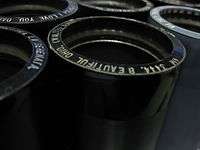Indestructible Record Company
| Indestructible Record Company | |
|---|---|
| Founded | 1906 |
| Founder | William Messer |
| Status | Defunct |
| Genre | Variety (classical, popular, etc.) |
| Country of origin | United States |
| Location | Albany, New York |

 |
Samuel Siegel and Roy Butin play Estillita Waltz.
An example of an Indestructible Record recording from 1908 with Samuel Siegel on mandolin and Roy Butin on guitar. |
| Problems playing this file? See media help. | |
The Indestructible Record Company was an American business that produced plastic cylinder records between 1907 and 1922.
The company was established by William Messer, who had previously worked with Thomas Lambert, the inventor of plastic celluloid cylinder records. The records were initially made, from 1900, by the Lambert Company, but that company went bankrupt in early 1906 after Thomas Edison brought a suit against Lambert for patent infringement. Messer had been responsible for developing a means of mass producing the Lambert cylinders using a steam press, and in 1906 set up his own company, the Indestructible Phonographic Record Co., based in Albany, New York, to record and produce them.[1][2]
The company was also known as the Albany Indestructible Record Company, and acquired the patent rights previously held by Lambert.[2] It produced celluloid cylinders in two-minute and, from 1909, four-minute versions, each having a cardboard core with metal reinforcing rings.[3] Between 1907 and 1922, it produced 1,598 titles, almost all of which have survived. The cylinders are described as "rugged", and "practically immune to splitting".[2]
From 1908 to 1912, the Indestructible company's output was distributed exclusively by Columbia Records.[4] After the arrangement with Columbia ended, the cylinders were sold directly by the firm as well as through Sears, Roebuck, and Montgomery Ward. In 1917 the company was re-organized as the Federal Record Corporation of Albany, New York, which began disc record production in 1919 as the Federal label.[5] Following a factory fire in 1922 the company ceased making cylinders, and it formally closed down in 1925.[1]
References
- ↑ 1.0 1.1 Frank Hoffman (ed.), Encyclopedia of Recorded Sound, Volume 1, CRC Press, 2004, p.261
- ↑ 2.0 2.1 2.2 Bill Klinger, Cylinder Records: Significance, Production, and Survival, Library of Congress, 2007, pp.4-14
- ↑ Edison Cylinder and Disc Record Development, July 1906. Retrieved 18 May 2013
- ↑ Walter L. Welch and Leah Brodbeck Stenzel Burt, From the Tinfoil to Stereo: The Acoustic Years of the Recording Industry, 1877-1929, University Press of Florida, 1994, p.85
- ↑ Sutton, Allan (2000). American Record Labels and Companies – An Encyclopedia (1891-1943). Mainspring Press. p. 83. ISBN 0-9671819-0-9.